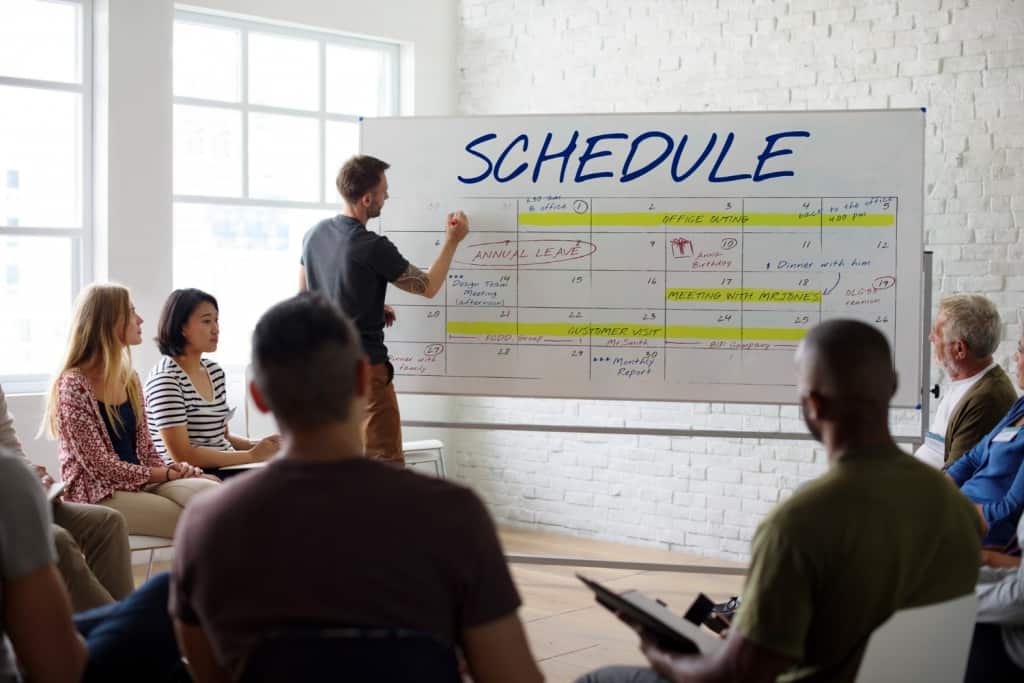초보자 가이드에 오신 것을 환영합니다. 이벤트 기획! 이 흥미진진한 세상에 처음 발을 들여놓고 여정을 시작하고 싶다면, 분명 좋은 기회가 있을 거예요! 이 블로그 게시물에서는 이벤트 기획의 필수 요소들을 소개하고, 완벽한 장소 선택부터 예산 책정, 물류 관리까지 이벤트 기획의 기본 단계들을 안내해 드립니다(무료 템플릿 포함).
기억에 남을 경험의 문을 열 준비를 하세요!
차례
- 회사 개요
- 이벤트 기획이란 무엇입니까?
- 이벤트 기획이 중요한 이유는 무엇입니까?
- 이벤트 기획은 누가 담당하나요?
- 이벤트 기획의 7단계는 무엇입니까?
- 성공적인 이벤트 기획을 만드는 방법
- 무료 이벤트 기획 템플릿
- 주요 요점
- 자주 묻는 질문

회사 개요
| 이벤트 기획의 5P는 무엇인가요? | 계획, 파트너, 장소, 실행 및 허가. |
| 이벤트의 5C는 무엇인가요? | 개념, 조정, 통제, 정점 및 종료. |
더 나은 참여를 위한 팁

이벤트 파티를 뜨겁게 달구는 대화식 방법을 찾고 계십니까?.
다음 모임을 위해 무료 템플릿과 퀴즈를 받아보세요. 무료로 가입하고 AhaSlides에서 원하는 기능을 마음껏 활용하세요!
🚀 무료 계정 받기
이벤트 기획이란 무엇입니까?
성공적인 행사를 위해 필요한 모든 구성 요소와 업무를 기획하고 조정하는 것을 이벤트 기획이라고 합니다. 이벤트 기획에는 행사 목적, 대상 고객, 예산, 물류, 장소 선정, 업체 선정, 일정, 그리고 전반적인 진행 등 다양한 요소들을 신중하게 관리하는 것이 포함됩니다.
예를 들어, 친구의 생일 파티를 계획한다고 가정해 보겠습니다. 이벤트 기획 단계는 다음과 같습니다.
- 파티 날짜, 시간 및 장소를 결정하십시오.
- 게스트 목록을 만들고 초대장을 보냅니다.
- 파티의 테마나 스타일, 장식, 포함하고 싶은 특정 활동이나 엔터테인먼트를 선택하세요.
- 음식, 음료 및 좌석 배치를 준비하십시오.
- 예상치 못한 문제를 관리하고 모든 것이 계획대로 진행되는지 확인하세요.
- ...
이벤트 기획이 중요한 이유는 무엇입니까?
이벤트 기획의 목표는 조직이 달성하고자 하는 목표가 될 수 있습니다. 즉, 이벤트 기획은 행사 준비 과정에 질서와 체계를 부여한다는 것을 의미합니다. 예를 들어, 모든 필수 요소를 사전에 신중하게 계획하고 조율하면 마지막 순간의 혼란을 방지하고 모든 것이 순조롭게 진행될 수 있도록 도와줍니다. 적절한 계획 없이는 행사 중 무질서, 혼란, 그리고 잠재적인 사고의 위험이 커집니다.
- 예를 들어, 발표자가 불참하고, 참석자들이 행사장 곳곳을 돌아다니는 데 어려움을 겪고, 발표 중 기술적인 문제가 발생하는 컨퍼런스를 상상해 보세요. 이러한 상황은 행사의 효과를 저해하고 참석자들에게 부정적인 경험을 초래할 수 있습니다. 효과적인 행사 기획은 이러한 문제를 예방하고 원활하고 효율적인 행사 진행을 보장합니다.

이벤트 기획은 누가 담당하나요?
이벤트 기획을 담당하는 사람이나 팀은 이벤트의 성격과 규모에 따라 다릅니다. 소규모 이벤트는 개인 또는 소규모 팀이 계획하고 실행할 수 있는 반면, 대규모 이벤트는 계획 프로세스를 효과적으로 처리하기 위해 보다 광범위한 전문가 및 자원봉사자 네트워크가 필요한 경우가 많습니다.
다음은 일반적으로 이벤트 계획과 관련된 몇 가지 주요 역할입니다.
- 이벤트 플래너/코디네이터: 이벤트 기획자 또는 코디네이터는 이벤트 기획 및 관리를 전문으로 하는 전문가입니다. 초기 컨셉 개발부터 실행까지 이벤트 기획의 모든 측면을 담당합니다. 또한, 고객 또는 이벤트 관계자와 긴밀히 협력하여 이벤트 목표 달성을 보장합니다.
- 이벤트 위원회/조직 위원회: 대규모 행사나 단체 또는 지역사회에서 주관하는 행사의 경우 행사위원회 또는 조직위원회를 구성할 수 있다. 그들은 마케팅 및 판촉, 후원 획득, 프로그램 개발, 물류 및 자원 봉사 조정과 같은 다양한 측면을 처리하기 위해 협력합니다.
참여 수준과 구체적인 역할은 이벤트의 규모, 복잡성, 사용 가능한 리소스에 따라 달라질 수 있다는 점을 알아두는 것이 중요합니다.
이벤트 기획의 7단계는 무엇입니까?

그렇다면 이벤트 기획 과정은 무엇이고, 몇 단계로 구성될까요? 이벤트 기획 과정은 일반적으로 다음과 같은 7단계로 구성됩니다.
1단계: 연구 및 개념화:
이벤트의 목적, 대상 고객, 업계 동향을 파악하기 위해 철저한 조사를 실시합니다. 이벤트의 목표, 주제, 그리고 원하는 결과를 간략하게 설명하는 명확한 컨셉을 개발합니다.
2단계: 계획 및 예산 책정:
필요한 모든 요소, 작업 및 일정을 포함하는 자세한 계획을 만듭니다. 행사의 여러 측면에 자금을 할당하는 포괄적인 예산을 개발합니다.
3단계: 장소 선택 및 공급업체 조정:
행사의 요건과 예산에 맞는 적합한 장소를 파악하고 확보하세요. 케이터링, 시청각 기술자, 데코레이터, 운송 서비스 등 관련 업체 및 서비스 제공업체와 협력하여 행사의 요구를 충족할 수 있도록 하세요.
4단계: 마케팅 및 판촉:
마케팅과 홍보는 이벤트 기획에서 가장 중요한 단계 중 하나입니다. 인지도를 높이고 참석자를 유치하기 위한 전략적 마케팅 및 홍보 계획을 수립하세요. 온라인 플랫폼, 소셜 미디어, 이메일 마케팅, 전통적인 광고 등 다양한 채널을 활용하여 타겟 고객에게 효과적으로 다가가 이벤트의 가치 제안을 전달하세요.
5단계: 이벤트 실행:
등록 및 발권, 좌석 배치, 시청각 설정 및 현장 관리를 포함하여 이벤트의 물류 측면을 감독합니다. 직원, 공급업체 및 자원봉사자와 협력하여 원활한 활동 흐름을 보장하고 이벤트 중에 발생할 수 있는 모든 문제를 해결합니다.
6단계: 참석자 참여 및 경험:
참석자들에게 매력적이고 기억에 남는 경험을 선사하십시오. 관심과 기대에 부응하는 활동, 프레젠테이션, 엔터테인먼트 및 네트워킹 기회를 계획하고 조직합니다. 전반적인 참석자 경험을 향상시키기 위해 간판, 장식 및 개인화 된 손길과 같은 세부 사항에 주의를 기울이십시오.
7단계: 행사 후 평가 및 후속 조치:
참석자, 이해관계자, 그리고 팀원들의 피드백을 수집하여 행사의 성공 여부를 평가합니다. 설정된 목표 대비 행사 결과를 분석하고 재정적 측면을 검토합니다.
개선 영역을 식별하고 향후 이벤트 계획 프로세스를 개선하기 위해 배운 교훈을 포착합니다. 또한 참석자, 후원자 및 파트너와 후속 조치를 취하여 감사를 표하고 관계를 유지하십시오.

성공적인 이벤트 기획은 어떻게 해야 할까?
이벤트 기획에 대한 보편적으로 합의된 요소는 없지만, 효과적인 이벤트 기획에 필수적인 것으로 간주되는 주요 요소는 다음과 같습니다.
1/ 명확한 목표:
행사의 목표와 목적을 확립하세요. 달성하고자 하는 바를 파악하고 그에 따라 모든 계획 활동을 조정하세요. 기금 모금, 네트워킹 강화, 제품 홍보, 중요한 사건 기념 등 어떤 목적이든 상관없습니다.
2/ 예산 관리:
현실적인 예산을 개발하고 장소, 케이터링, 장식, 마케팅 및 물류를 포함하여 이벤트의 다양한 측면에 자금을 할당합니다.
비용을 정기적으로 추적하고 예산 범위 내에서 유지하십시오. 비용 효율적인 옵션의 우선 순위를 지정하면서 원하는 결과를 달성하기 위해 자금을 전략적으로 할당합니다.
3/ 전략적 계획 및 일정:
모든 작업, 책임 및 기한을 설명하는 포괄적인 계획을 만듭니다. 계획 프로세스를 초기 개념 개발에서 이벤트 후 평가에 이르기까지 관리 가능한 단계로 세분화합니다.
자세한 일정은 원활한 조정을 보장하고 필요에 따라 조정할 수 있습니다.
4/ 이벤트 디자인 및 테마:
원하는 분위기나 테마를 반영하는, 조화롭고 매력적인 이벤트 디자인을 만들어 보세요. 여기에는 장식, 간판, 조명, 그리고 이벤트의 분위기를 조성하는 전반적인 미적 요소 등이 포함됩니다.
5/ 물류 및 운영:
이벤트 등록, 발권, 교통, 주차, 시청각 요구 사항 및 현장 관리를 포함한 물류 세부 사항에 세심한 주의를 기울이십시오. 필요한 모든 리소스를 효과적으로 조정하여 원활한 운영을 보장합니다.
6/ 평가 및 피드백:
피드백을 수집하고 그 영향을 평가하여 이벤트의 성공 여부를 평가합니다.
참석자 만족도를 분석하고, 설정된 목표에 대한 결과를 측정하고, 향후 이벤트에서 개선할 영역을 식별합니다.
무료 이벤트 기획 템플릿
이벤트 계획의 7단계를 통합한 이벤트 계획 템플릿은 다음과 같습니다.
| 단계 | 작업 | 책임있는 당사자 | 마감 시간 |
| 연구 및 개념화 | 이벤트 목적, 목표 및 주제 정의 | ||
| 시장 조사 수행 및 업계 동향 분석 | |||
| 이벤트 개념 개발 및 주요 메시지 개요 | |||
| 계획 및 예산 편성 | 작업 및 일정으로 자세한 이벤트 계획 만들기 | ||
| 장소, 케이터링, 마케팅 등에 예산을 할당합니다. | |||
| 비용을 추적하고 정기적으로 예산을 검토하십시오. | |||
| 장소 선택 및 벤더 조정 | 잠재적 장소 조사 및 식별 | ||
| 공급업체 및 공급업체와 연락 및 협상 | |||
| 계약 체결 및 물류 조정 | |||
| 마케팅 및 판촉 | 마케팅 전략 및 대상 고객 개발 | ||
| 온라인 플랫폼, 소셜 미디어 및 광고 활용 | |||
| 홍보 콘텐츠 및 자료 제작 | |||
| 이벤트 실행 | 이벤트 물류, 등록 및 발권 관리 | ||
| 직원, 자원봉사자, 공급업체 조정 | |||
| 현장 활동 및 게스트 경험 감독 | |||
| 참석자 참여 및 경험 | 매력적인 활동, 프레젠테이션 및 네트워킹 계획 | ||
| 디자인 이벤트 레이아웃, 간판 및 장식 | |||
| 참석자 경험 및 세부 정보 개인화 | |||
| 이벤트 후 평가 및 후속 조치 | 참석자와 이해 관계자로부터 피드백을 수집합니다. | ||
| 이벤트 결과를 분석하고 참석자의 만족도를 평가합니다. | |||
| 개선할 영역과 배운 교훈을 식별합니다. | |||
| 참석자 및 파트너에게 감사를 표하고 후속 조치를 취하십시오. |
주요 요점
이벤트 기획은 성공적이고 잊지 못할 이벤트를 만들기 위해 철저한 조사, 전략적 계획, 그리고 완벽한 실행을 요구하는 역동적인 과정입니다. 기업 컨퍼런스, 결혼식, 지역 사회 모임 등 어떤 행사든 효과적인 이벤트 기획은 목표 달성, 참석자들의 적극적인 참여, 그리고 긍정적인 경험 제공을 보장합니다.
그 위에, 아하 슬라이드 AhaSlides는 인터랙티브 기능을 활용하여 특별한 이벤트를 제작하는 데 도움을 드립니다. 매력적인 프레젠테이션부터 실시간 청중 상호작용까지, AhaSlides는 이벤트를 한 단계 더 발전시킬 수 있는 다양한 도구를 제공합니다. AhaSlides의 라이브러리를 살펴보세요. 기성품 템플릿 지금 참석자들의 흥분이 치솟는 것을 목격하십시오!
자주 묻는 질문들 (FAQ)
궁금한 점이 있으신가요? 답변해 드리겠습니다.








